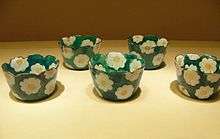Ogata Kenzan
Ogata Kenzan (尾形 乾山, 1663–1743), originally Ogata Shinsei (尾形 深省), and also known by the pseudonym Shisui, was a Japanese potter and painter.
Biography


He was born in Kyoto in a rich merchant family. His older brother was Ogata Kōrin. He learned from the famous potter Nonomura Ninnsei and made his own kiln. In 1712 a nobleman began patronizing his kiln, he moved to the east area of Kyoto. He was one of the greatest ceramicists of the Tokugawa era. In 1713, he moved to Edo where he also spend the rest of his life.
Ogata Kenzan produced a distinctive style of freely brushed grasses, blossoms, and birds as decorative motifs for pottery. His pieces were noted for their perfect relation between design and shape. He often collaborated on the decoration of pottery with his older brother, Ogata Korin (1658–1716), after whom the style known as Rimpa (Korin + pa meaning “school”) was named.
Bernard Leach, the famous studio potter, wrote a book about Ogata Kenzan in 1966 entitled Kenzan and his Tradition, published by Faber & Faber in London.
External links
![]() Media related to Ogata Kenzan at Wikimedia Commons
Media related to Ogata Kenzan at Wikimedia Commons
- Bridge of dreams: the Mary Griggs Burke collection of Japanese art, a catalog from The Metropolitan Museum of Art Libraries (fully available online as PDF), which contains material on Ogata Kenzan (see index)
- Pottery works by Ogata Kenzan
- Bowl with bamboo leaf design at Kimball Art Museum